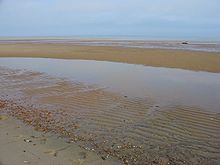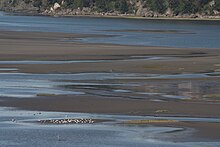Mudflat
Mudflats or mud flats, also known as tidal flats or, in Ireland, slob or slobs,
A recent global remote sensing analysis estimated that approximately 50% of the global extent of tidal flats occurs within eight countries (Indonesia, China, Australia, United States, Canada, India, Brazil, and Myanmar) and that 44% of the world's tidal flats occur within Asia (56,051 km2 or 21,641 sq mi).[3] A 2022 analysis of tidal wetland losses and gains estimates that global tidal flats experienced losses of 7,000 km2 (2,700 sq mi) between 1999 and 2019, which were largely offset by global gains of 6,700 km2 (2,600 sq mi) over the same time period.[5]
In the past tidal flats were considered unhealthy, economically unimportant areas and were often dredged and developed into agricultural land.[6] Some mudflats can be extremely treacherous to walk on. For example, the mudflats surrounding Anchorage, Alaska, are made from fine glacial-silt which does not easily separate out its water, and, although seemingly solid, can quickly gel and become like quicksand when disturbed by stepping on it. Four people are known to have become stuck up to their waists and drowned when the tide came in, and many others are rescued from the Anchorage mudflats each year.[7]
On the Baltic Sea coast of Germany in places, mudflats are exposed not by tidal action, but by wind-action driving water away from the shallows into the sea. This kind of wind-affected mudflat is called Windwatt in German.[citation needed]
Ecology
Tidal flats, along with intertidal
The maintenance of mudflats is important in preventing coastal erosion. However, mudflats worldwide are under threat from predicted
Mudflat sediment deposits are focused into the intertidal zone which is composed of a barren zone and marshes. Within these areas are various ratios of sand and mud that make up the sedimentary layers.[14] The associated growth of coastal sediment deposits can be attributed to rates of subsidence along with rates of deposition (example: silt transported via river) and changes in sea level.[14]
Barren zones extend from the lowest portion of the intertidal zone to the marsh areas. Beginning in close proximity to the tidal bars, sand dominated layers are prominent and become increasingly muddy throughout the tidal channels. Common bedding types include laminated sand, ripple bedding, and bay mud. Bioturbation also has a strong presence in barren zones.

Salt pans can be distinguished in that they contain thinly laminated layers of clayey silt. The main source of the silt comes from rivers. Dried up mud along with wind erosion forms silt dunes. When flooding, rain or tides come in, the dried sediment is then re-distributed.[14]


Selected example areas
- Arcachon Bay, France
- Banc d'Arguin, Mauritania
- Chamiza Wetland, Chile
- Great Rann of Kutch, India
- Belhaven, East Lothian Scotland, United Kingdom
- Bridgwater Bay and Morecambe Bay, United Kingdom
- Cape Cod Bay, Massachusetts, United States
- Cook Inlet, Alaska, United States
- Lindisfarne Island, England, United Kingdom
- Minas Basin, Nova Scotia, Canada
- Moreton Bay, Queensland, Australia
- North Slob, Wexford, Ireland
- Kneiss Archipelago, Tunisia
- Padilla Bay, Washington, United States
- Plymouth Bay, Massachusetts, United States
- Port of Tacoma, Washington, United States
- Warm Beach, Washington, United States
- Skagit Bay, Washington, United States
- Snettisham, Norfolk England, United Kingdom
- Wadden Sea: Netherlands, Germany, Denmark
- West coast of Andros Island, Bahamas
- Yellow Sea: China, North Korea, South Korea
See also
- Herringbone cross beds
References
- ^ "Sloblands". www.askaboutireland.ie.
- ^ Roche, Richard. "Celebrating the Slobs". The Irish Times.
- ^ a b c d
Murray, N.J.; Phinn, S.R.; DeWitt, M.; Ferrari, R.; Johnston, R.; Lyons, M.B.; Clinton, N.; Thau, D.; Fuller, R.A. (2019), "The global distribution and trajectory of tidal flats", Nature, 565 (7738): 222–225, S2CID 56481043/
- ^ Swamps and marshes (with thick and deep mud beneath surfaces in hot season) are either freshwater, salty, or brackish.
- S2CID 248749118.
- ^ "Dredging Indian River Lagoon Wetlands 1920 - 1950s". Archived from the original on 2013-03-20. Retrieved 2011-10-28.
- ^ Associated Press - Man dies on Alaskan Mudflat
- ^ "Indian River Lagoon Species Inventory Home". irlspecies.org.
- ^ Aldea, K. (2022). The Unvegetated Tidal Flats in Catanduanes Island, Philippines: Current and Future Trends. In T. Shinbo, S. Akama & S. Kubota (Eds.), " Interdisciplinary Studies for Integrated Coastal Zone Management in the Region along the Kuroshio: Problem-Based Approach by Kuroshio Science" (pp.76-82).https://kochi.repo.nii.ac.jp/?action=pages_view_main&active_action=repository_view_main_item_detail&item_id=8635&item_no=1&page_id=13&block_id=21
- ^ Triño, A. T., & Rodriguez, E. M. (2000). Mud crab (Scylla serrata) culture in tidal flats with existing mangroves. In J. H. Primavera, M. T. Castaños, & M. B. Surtida (Eds.), Mangrove-Friendly Aquaculture: Proceedings of the Workshop on Mangrove-Friendly Aquaculture organized by the SEAFDEC Aquaculture Department, January 11–15, 1999, Iloilo City, Philippines (pp. 171–176). Aquaculture Department, Southeast Asian Fisheries Development Center. https://repository.seafdec.org.ph/handle/10862/454
- ^ "Manko - Tidal Flat, Mangrove Forest" (PDF).
- ISBN 9782831712550, archived from the originalon 2014-06-24, retrieved 2014-08-01
- ^
Murray, N.J.; Clemens, R.S.; Phinn, S.R.; Possingham, H.P.; Fuller, R.A. (2014), "Tracking the rapid loss of tidal wetlands in the Yellow Sea" (PDF), Frontiers in Ecology and the Environment, 12 (5): 267–272, doi:10.1890/130260/
- ^ ISBN 0-387-10189-6.




